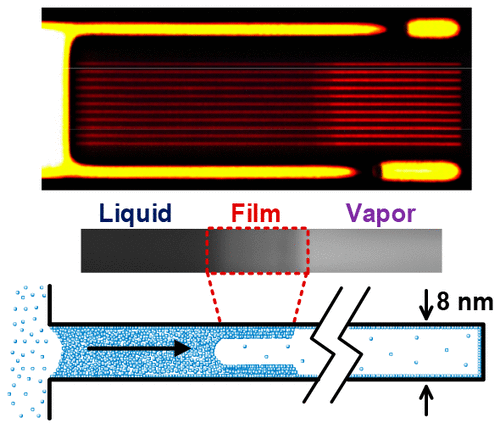当前位置:
X-MOL 学术
›
J. Phys. Chem. Lett.
›
论文详情
Our official English website, www.x-mol.net, welcomes your
feedback! (Note: you will need to create a separate account there.)
Capillary Condensation in 8 nm Deep Channels
The Journal of Physical Chemistry Letters ( IF 4.8 ) Pub Date : 2018-01-16 00:00:00 , DOI: 10.1021/acs.jpclett.7b03003 Junjie Zhong 1 , Jason Riordon 1 , Seyed Hadi Zandavi 2 , Yi Xu 1 , Aaron H. Persad 1, 2 , Farshid Mostowfi 3 , David Sinton 1
The Journal of Physical Chemistry Letters ( IF 4.8 ) Pub Date : 2018-01-16 00:00:00 , DOI: 10.1021/acs.jpclett.7b03003 Junjie Zhong 1 , Jason Riordon 1 , Seyed Hadi Zandavi 2 , Yi Xu 1 , Aaron H. Persad 1, 2 , Farshid Mostowfi 3 , David Sinton 1
Affiliation

|
Condensation on the nanoscale is essential to understand many natural and synthetic systems relevant to water, air, and energy. Despite its importance, the underlying physics of condensation initiation and propagation remain largely unknown at sub-10 nm, mainly due to the challenges of controlling and probing such small systems. Here we study the condensation of n-propane down to 8 nm confinement in a nanofluidic system, distinct from previous studies at ∼100 nm. The condensation initiates significantly earlier in the 8 nm channels, and it initiates from the entrance, in contrast to channels just 10 times larger. The condensate propagation is observed to be governed by two liquid–vapor interfaces with an interplay between film and bridging effects. We model the experimental results using classical theories and find good agreement, demonstrating that this 8 nm nonpolar fluid system can be treated as a continuum from a thermodynamic perspective, despite having only 10–20 molecular layers.
中文翻译:

8 nm深通道中的毛细管凝结
纳米级的冷凝对于理解许多与水,空气和能源有关的天然和合成系统至关重要。尽管它很重要,但在10纳米以下,凝结引发和扩散的基本物理原理仍然未知,这主要是由于控制和探测这种小型系统的挑战。在这里我们研究n的凝聚丙烷在低至8 nm的纳米流体系统中的局限性,与之前在约100 nm的研究不同。与8倍大的通道相比,凝结在8 nm通道中明显更早地开始,并且从入口开始。观察到冷凝水的传播受两个液-气界面的控制,薄膜和桥接效应之间相互作用。我们使用经典理论对实验结果进行建模,并找到了良好的一致性,表明从热力学角度来看,尽管只有10–20个分子层,但该8 nm非极性流体系统仍可以视为连续体。
更新日期:2018-01-16
中文翻译:

8 nm深通道中的毛细管凝结
纳米级的冷凝对于理解许多与水,空气和能源有关的天然和合成系统至关重要。尽管它很重要,但在10纳米以下,凝结引发和扩散的基本物理原理仍然未知,这主要是由于控制和探测这种小型系统的挑战。在这里我们研究n的凝聚丙烷在低至8 nm的纳米流体系统中的局限性,与之前在约100 nm的研究不同。与8倍大的通道相比,凝结在8 nm通道中明显更早地开始,并且从入口开始。观察到冷凝水的传播受两个液-气界面的控制,薄膜和桥接效应之间相互作用。我们使用经典理论对实验结果进行建模,并找到了良好的一致性,表明从热力学角度来看,尽管只有10–20个分子层,但该8 nm非极性流体系统仍可以视为连续体。











































 京公网安备 11010802027423号
京公网安备 11010802027423号